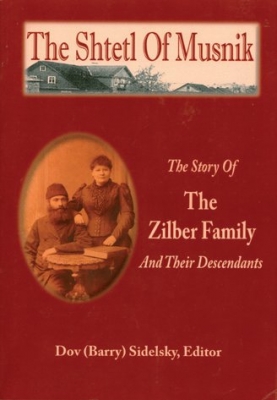The Shtetl of Musnik
The Shtetl of Musnik: The Story of the Zilber Family and their Descendants
By Dov (Barry) Sidelsky
Mazo Publishers. 2012 Paperback. 113 pages. ISBN 978-1-936778-65-2.
Reviewed by Carl Hoffman
As its title would imply, this book about a Jewish shtetl in Lithuania is essentially the history of one family. The book's author is one of the family's descendants.
Generally speaking, family histories, no matter how well written or lavishly illustrated, are of interest to no one but members of the family—and sometimes not even to all of the family. This book, however, has the added value of supplying a wealth of information that will engage anyone who is interested in the history of the Jewish people in Eastern Europe, especially during the 19th and 20th centuries.
The Shtetl of Musnik provides some valuable insights in a microcosm of what life was like in the predominantly Jewish towns and villages of Eastern Europe, as well as what happened to the Jews who left those towns to join the great diaspora of the late 19th century and, tragically, what happened to the Jews who stayed behind. The book's narrative begins in the early 18th century and ends with the mass murder of the town's Jews by the Germans and their Lithuanian allies on September 5, 1941.
The first half of the book concerns the shtetl itself. We learn through documentary evidence of how a Jewish community established itself and developed. We see the community in its full glory, with synagogues and study houses, sages and students, butchers and bakers, and peddlers who enlivened colorful market days when Jews and gentiles met as neighbors and friends. We see numerous photographs of people and houses—even a town street map—that enable us to envision exactly how such a town was laid out, who lived where, and how the town's residents made use of their space and resources. Through a variety of historical documents and letters, including recent correspondence with a current non-Jewish resident of Musnik, we are able to follow the history of the Jewish community through the early 20th century, right up to its destruction in 1941.
The second half of the book concerns the Zilber family of Musnik, and it too is interesting and valuable for the further light it sheds on the dispersion of Eastern European Jews to virtually all points of the compass in the late 19th century—to England, Canada, the United States, Palestine, South America and, for many Lithuanian Jews like the Zilbers, to South Africa. Through stories of individual members of the Zilber family we gain further understanding of how Jews came to South Africa, established communities there, and prospered through the 20th century.
Many of the world's Jews today are descendants of those who lived in Eastern Europe. Although ostensibly the story of only one family, The Shtetl of Musnik is more broadly the story of a very large part of the world's Jewish family. It is not only about the Zilbers, but about us as well.








Comments